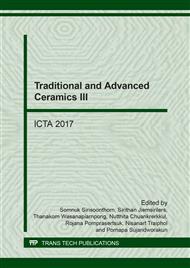p.1
p.7
p.13
p.19
p.28
p.34
p.40
p.44
Porous Alumina Processing Using the Direct Foaming Technique Based on Slurry Boiling
Abstract:
The effect of slurry solids content was studied for a novel direct foaming method based on slurry boiling to produce porous alumina ceramics. Slurries with solids contents of 30 to 45 wt. % were produced by conventional processing methods. The physical properties of slurry density and surface tension were measured, as well as thermal properties such as specific heat and latent heat, which were obtained using differential scanning calorimetry (DSC). Samples were fabricated by boiling the slurries on a hot plate until the liquid was completely evaporated. The resultant porous samples were presintered at 1000 °C and were examined to determine the pore size and structure. The measured pore diameter of samples obtained from this experiment were compared with theoretical calculations of departing bubble diameter from a heated surface proposed by Fritz, and Cole & Rohsenow. It was found that the pore size had a relationship with slurry solids content depending on the thermal gradient. The pore size, at a position away from the heated surface, increased as the solids content increased. However, the pore size at the heated surface did not vary significantly with solids content. The results showed that a direct foaming method based on slurry boiling is capable of producing porous alumina and that solids content of the slurry may be utilized to somewhat control pore size and structure.
Info:
Periodical:
Pages:
1-6
Citation:
Online since:
April 2018
Authors:
Keywords:
Price:
Сopyright:
© 2018 Trans Tech Publications Ltd. All Rights Reserved
Share:
Citation:


